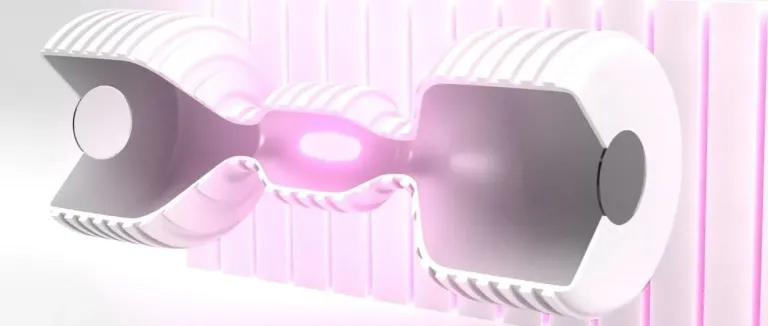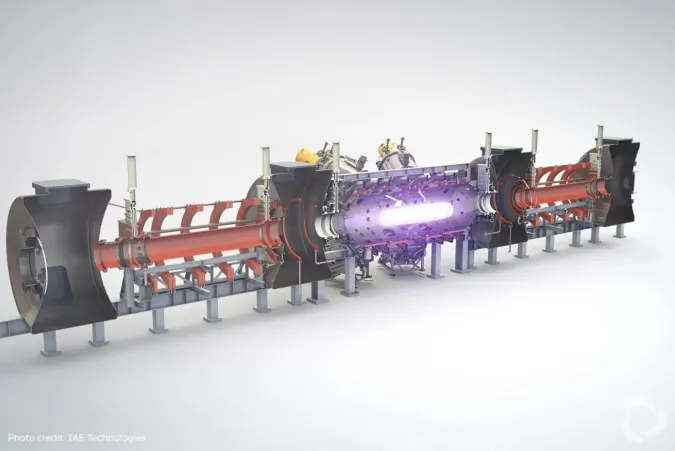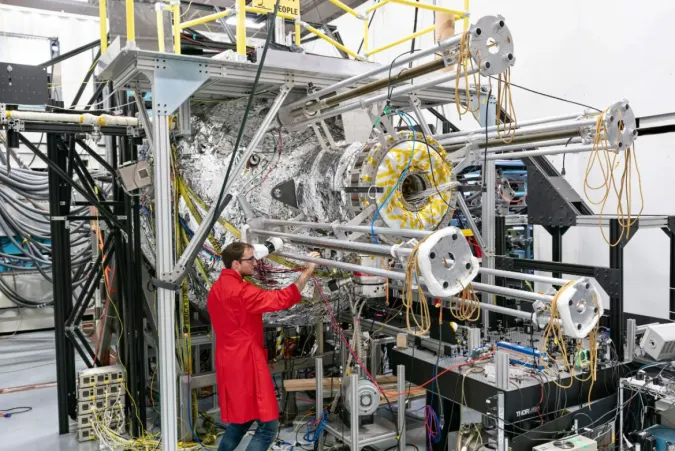One solution for meeting that demand, currently being pursued by researchers around the globe, is to build nuclear-fusion power plants.
Global power demand is expected to double by 2040 and could increase fivefold by 2060 as electrification expands to new applications. One solution for meeting that demand, currently being pursued by researchers around the globe, is to build nuclear-fusion power plants capable of supplying grid-scale electricity with zero emissions of climate-altering gases.
The technology would replicate the processes of the sun, which has been releasing a tremendous amount of energy for millions of years by converting matter through nuclear fusion, including the transition of hydrogen isotopes into helium atoms. Everything in nature, as we all know, tends to a condition of the least potential energy, and we all tend to the ideal state of rest. An item held 1 meter from the ground will fall to the ground if released; i.e., it will gravitate to a state of minimal potential energy — in this instance, gravitational energy.
Although potential energy at the atomic level has a different nature, everything works in a similar way. In the fusion reaction, the nuclei of two isotopes fuse so that they both go to a lower energy state, releasing the excess energy. However, the fusion reaction requires very high-pressure and high-temperature environments so that the nuclei are close enough to each other in the plasma state (the so-called fourth state of matter).
Isotopes of a given element vary according to the number of neutrons. The nucleus of a hydrogen atom is created by a single proton, and hydrogen isotopes differ depending on the other particles: Deuterium has a nucleus with one proton and one neutron, tritium has two neutrons, hydrogen-4 has three neutrons, and so on.
In the transfer of mass into energy, nuclear-fusion reactions use Einstein’s ratio: E = mc2. Positively charged nuclei will tend to repel each other, so the hydrogen nuclei must be able to approach very close to other hydrogen nuclei that still have protons in order to achieve the fusion goal. This allows nuclear forces to bind them together, resulting in a heavier particle.
Temperature and plasma
High-temperature heat thermally agitates particles, and the resultant disordered motion could help them bind. If they are positively charged, they will repel each other, so it will be necessary to reach a temperature of at least 100 million degrees Celsius for fusion to occur. Such high temperatures are difficult to achieve due to the difficulty of locating suitable material for use as a container.
However, the extremely high heat (and, hence, energy) required to heat a hydrogen-containing gas would pull an electron off its nucleus, leaving it with only its positive charge (ionization). Furthermore, at these temperatures, the hydrogen gas would have two separate currents — one negative, from the electrons torn from the nucleus, and the other positive, from the surviving protons — and the gas would become a plasma. Magnetic fields would affect the currents created at this location. Only a magnetic field would be able to capture and confine the plasma in its coils, keeping it away from the containment walls.
A magnetic confinement reactor called a tokamak uses a toroidal (doughnut-shaped) container structure.
While substantial energy will be needed to create the plasma and keep it contained, the energy generated by nuclear fusion exceeds the energy expended to get it. The gain factor is the proportion of energy gained versus energy wasted (Q). It’s also important that the plasma remain stable — i.e., contained — for an extended period. Temperature and confinement duration are critical criteria for demonstrating nuclear fusion’s potential.
In tokamak reactors, the hot plasma flows are enclosed within the toroidal container, wrapped, imprisoned, and regimented by magnetic fields (like those that guide the high-temperature particle beams running in large accelerators).
In the fusion reactor, only hydrogen, the most basic element in nature, interacts. Its energy processes produce no waste, hazardous products, radioactive waste, or other chemicals, because no chemical components like hydrocarbons, coal, or heavy elements such as uranium are used. The single result of fusion, helium, is a light, inert, and safe gas.
In a fusion power plant, radioactivity is limited to the treatment of reactor materials activated by neutron flux that are already in operation, as well as the storage of tritium (which decays in 12 years), an operation involving light radioactive isotopes that is now common in every hospital or service that uses isotopes for diagnosis and treatment. Finally, unlike fission reactions, nuclear-fusion processes do not function in a chain: If the plasma flow is not supplied, the reaction will halt.
Simply turn off the electricity. The concept of intrinsic and passive safety is thereby implemented.
Fusion technologies
Helion Energy’s Trenta prototype merged and compressed high-beta field-reversed configuration (FRC) deuterium plasmas under fusion conditions, achieving a 9-keV total plasma temperature (over 100 million degrees Celsius) in bulk with operation above an 8-keV ion temperature and 1-keV electron temperature. In 2018, its fifth-generation prototype produced magnetic fields of 7 T and reached an ion temperature of 2 keV at high density.
The system is made up of magnets that accelerate two FRCs from opposite ends of the 40-foot accelerator to 1 million mph. After that, they clash in the middle. When the FRCs meet at the system’s core, a magnetic field compresses them until they achieve fusion temperatures. The deuterium and helium-3 ions travel swiftly at this temperature, overcoming the forces that reject them and allowing the ions to join, or fuse. As a result, energy is released, and the plasma expands, pushing against the magnetic field. The change in field causes current to flow and, hence, electricity to be produced, which is used to power electrical loads (Figure 1).
FRC devices confine plasma on closed magnetic field lines in the form of a self-stable torus. Together with the spheromak, they are considered part of the compact toroid class of fusion devices. FRC devices normally have more elongated plasma than spheromaks.

The reactor used by the ITER multinational fusion research project is a tokamak design. The doughnut-shaped vacuum chamber of the tokamak is its beating heart. The vacuum chamber is free of air and contaminants. Magnets hold and regulate the plasma, which is charged before the gaseous fuel is introduced. When a large electrical current is passed through the vessel, the gas breaks down electrically, becomes ionized when electrons are stripped from the nuclei, and produces plasma.
ITER uses superconducting magnets to confine the plasma (toroidal field coils) and maintain its form and stability (poloidal field coils). A magnetic cage separates the plasma from the containment vessel. When driven by 68,000 A, the magnetic field may reach 11.8 T, nearly 250,000× that of Earth’s magnetic field.
Each magnet is 17 × 9 meters in size and weighs 320 tons.

Other fusion components include the vacuum vessel, a double-walled container used to house the fusion reaction in a vacuum. Cryogenic systems cool magnets and achieve ideal vacuum conditions. Remote handling systems use human-assisted robotics and virtual reality to monitor, maintain, and replace components. Diagnostic systems monitor tokamak plasma performance.
TAE Technologies, founded in 1998 as a privately held spinoff of the University of California, Irvine, has a proprietary approach to fusion. The approach uses a mechanism that produces and confines plasma and operates at higher temperatures to achieve fusion with greater stability, and therefore greater safety, than other technologies that try to exploit the process that powers the sun.
TAE’s concept arose from a desire to overcome the challenges that traditional tokamak reactors face, such as the necessity for deuterium-tritium–handling technologies, tritium scarcity, and the size and expense of superconducting magnets. The TAE reactor is powered by hydrogen and boron. Only three helium nuclei, known as alpha particles, and X-rays are produced in hydrogen-boron fusion, and their energy is utilized to power a turbine.
TAE Technologies’ staff of engineers and scientists work in the California labs, but globally, TAE has a staff of 250 people specializing in reactor development and nuclear-fusion technologies. The company has raised more than US$880 million in private funding from institutional investors, including Google, NEA, Venrock, and Wellcome Trust, and family foundations Addison Fischer, the Samberg Family, and Charles Schwab, among others.

General Fusion uses a plasma-confinement method, dubbed Magnetized Target Fusion (MTF), that relies on simple electromagnets operating on a pulsed basis to achieve fusion. The process can be repeated in a cycle.
It works like this:
• A vessel is filled with liquid metal, which is spun until the metal forms a cavity. • Hydrogen plasma is injected into the resulting cavity. • The plasma is compressed and heated to more than 100 million degrees Celsius, and fusion occurs.
The MTF plasma injector is powered by electromagnets. Because of the swirling motion, an injector creates a ring of plasma that creates a magnetic field, which forms a cloud of particles. The plasma ring is squeezed to temperatures and pressures at which nuclear fusion should occur. Plasma particles move along magnetic field lines, which then circulate without ever colliding with the wall. The magnetic field prevents the hot fusion plasma from colliding with the liquid metal and cooling. As the plasma core heats up, the magnetic field functions as a good thermal insulator.
According to General Fusion, MTF has four key advantages:
• Material durability. The liquid metal liner shields the MTF structure from neutrons released by the fusion reaction, overcoming the problem of structural damage to plasma-facing materials.
• Fuel production. The fusion process starts by filling a tank with liquid metal, spinning the metal until a cavity is formed. General Fusion injects hydrogen plasma into the cavity.
• Energy conversion. In the pilot plant, heat would be extracted from metal and used to make steam. The steam would drive a turbine and produce electricity.
• Energy economics. General Fusion claims that MTF is straightforward to manufacture and scale because it uses simple electromagnets and does not require expensive lasers.

First Light, meanwhile, uses a technique based on inertial confinement, with the goal of achieving fusion conditions by rapidly compressing the fusion fuel and using the inertia of the fuel to sustain those conditions long enough to activate the fusion reaction.
It’s difficult to perfect a process that requires atoms to be heated to the sun’s temperature for a longer period of time, especially if the atoms must remain at that temperature for extended periods. First Light cuts the time it takes to keep the temperature constant by directing the fuel toward a rapid projectile; as a result, the fusion process occurs in a fraction of a second. First Light thinks that its method will avoid some of the most difficult aspects of fusion-reactor construction.
Timetable
Proceeding along several research routes, as described here, the global effort to achieve viable fusion-based power is projected to succeed within one or two decades. That’s a rather short time when we remember that the earliest scientific investigations into fusion date back to the 1930s and the tokamak solution was born in the 1950s.







